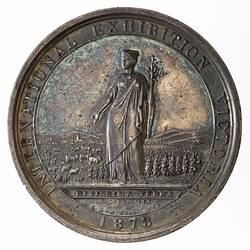Charles Hubert de Castella was born in 1825 in Neuchatel, Switzerland and educated by the Jesuits at Fribourg. He then went to Germany and then in 1843 to France, where he studied architecture for several years and was naturalised. From 1848 to 1853 he served with the First Regiment of the Chasseurs.
His brother Paul migrated to Victoria in 1849 and became a land-owner and vigneron; Hubert followed in 1854. In 1855 he bought a 15,000 acre station adjacent to his brother and ran cattle in partnership with Guillaume de Pury. Only nine months later he decamped to Switzerland, leaving his partner in charge; de Pury sold the station in 1858 and went to Switzerland himself in 1861. In 1862 both returned to Australia, intending to take up sheep farming, but were discouraged by the high price of sheep and encouraged by the reputation of Victorian wines. They decided to establish a vineyard, and Castella bought part of his brother's former property, which he renamed St Hubert's after his patron saint. He planted around 100 acres of vines, increasing this later to 250 acres. The development of the vineyard was only made possible by the gradual sale of properties owned by his wife Alice Frances Jenkins, who he had married in 1865. To compensate for his lack of knowledge and experience as a vigneron he travelled and read widely, and to overcome marketing difficulties formed a partnership in 1859 with Andrew Rowan, who opened cellars in Melbourne. In 1879 Castella won a (NU 17913) at the International Exhibition. However the turning point in the success of the vineyard was a trophy from the emperor of Germany for the Australian exhibitor whose product showed the greatest industrial or artistic progress at the 1880 Melbourne Exhibition.
Castella was devoted to his adopted country. He wrote several books about Australia and Australian wines. He was also a talented artist: he painted oil landscapes and engravings and some of his work appeared in the first volume of Le Tour de Monde (1861). He and Alice also parented five daughters and five sons.
A silver prize medal was awarded to Hubert de Castella at the 1873 Victorian Exhibition for wine. Castella had multiple entries in Section VI: wine, beer, etc: #786: Chasselas (three, white-light); #787: Heritage (three, red - light and dry); #788: Savignon (one, red - full-bodied); and #789: Brandy. All came from Yering, an area of rich loam with clay sub-soil (Offical Record, p.58).
Castella returned to Switzerland in 1886 after an estrangement with his partner Rowan, leaving his oldest son Francois to manage the vineyard. He returned to Victoria in 1906 to enjoy once more the warmth and brightness of the Australian sunshine. He died in Ivanhoe, Victoria, on 30 October 1907.
References:
Australian Dictionary of Biography.
More Information
-
Keywords
-
Localities
Neuchatel, Switzerland, Yarra Valley, Victoria, Australia, Melbourne, Victoria, Australia
-
Authors
-
Article types

